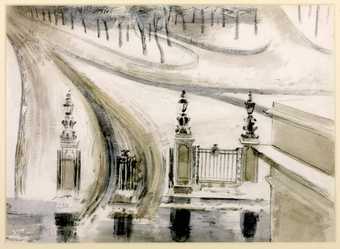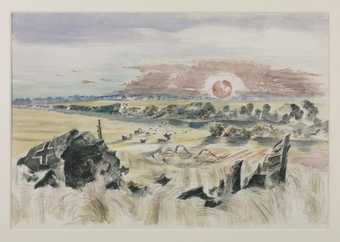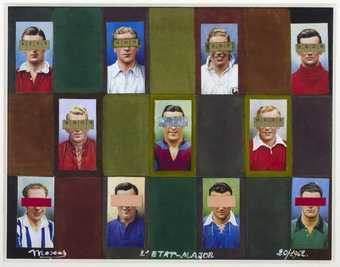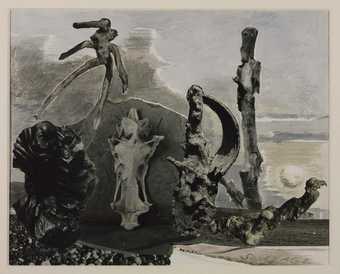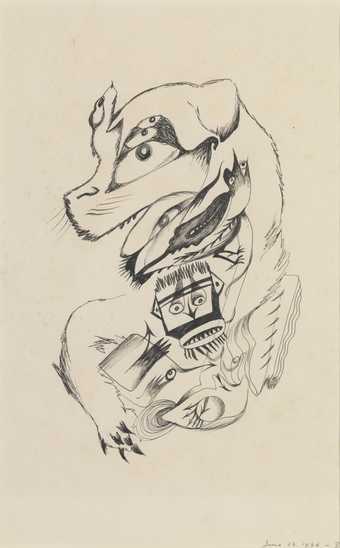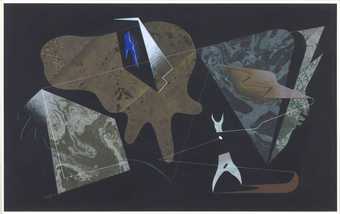
Not on display
- Artist
- Sir Roland Penrose 1900–1984
- Medium
- Postcards, graphite and watercolour on paper on board
- Dimensions
- Support, secondary: 558 × 813 mm
frame: 594 × 849 × 23 mm - Collection
- Tate
- Acquisition
- Purchased 1976
- Reference
- T02021
Display caption
Roland Penrose was probably the most important figure in British Surrealism. He provided a vital link with Parisian artists such as Pablo Picasso, Max Ernst and Man Ray.Penrose invented the ‘post-card sculpture’,in which a new reality is created by the incongruous juxtaposition of views of diverse real places. In this mysterious image, views of two landmarks in Paris – the Eiffel Tower and the Opera House – have been transformed into a mechanized moth drawn, fatally, towards a candle flame.
Gallery label, August 2004
Does this text contain inaccurate information or language that you feel we should improve or change? We would like to hear from you.
Catalogue entry
T02021 MAGNETIC MOTHS 1938
Inscribed ‘R. Penrose 38’ b.r.
Collage (pencil and watercolour on cardboard), 32×22 (81.3×55.8)
Purchased from the artist (Gytha Trust) 1976
Exh:
Roland Penrose, Mayor Gallery, June 1939 (15); British Surrealist and Abstract Paintings, County Borough of Northampton Art Gallery, Northampton, July–August, 1939 (52); Le Surréalisme, Galerie Charpentier, Paris, 1964 (253); The Enchanted Domain, Exeter City Art Gallery, 1967 (105); Britain's Contribution to Surrealism, Hamet Gallery, 1971 (91); Ausstellung die Surrealismus, Haus der Kunst, Munich, 1972 (363); Le Surréalisme, Musée des Arts Decoratifs, Paris, 1972 (348, repr.)
Lit: René Magritte and Paul Nougé, ‘Colour Colours’, The London Bulletin, No. 17, 1939, pp.9–12
The following information was obtained in conversation with the artist on 9 June 1976.
‘Magnetic Moths’ is one of a series of collages that the artist made from 1936 onwards. All incorporate a series of brightly coloured postcards with photographs of French scenes. These collages usually contain depictions of the Mediterranean. ‘Magnetic Moths’ is an exception because it contains only Parisian scenes.
The idea first came to the artist in 1936 when he was staying in the South of France at a hotel called Le Vaste Horizon in Mougins, with Picasso, Dora Maar, Man Ray, Paul Eluard and others, (see Roland Penrose, Picasso his Life and Work, p.261). Penrose was attracted to the bright garish postcards of banal scenes on sale everywhere and he bought them by the dozen. As a Surrealist he was interested in the possibilities of experimenting with these cards and was excited to discover that by arranging them in a series of repeated images he had created a new language whereby pattern and colour became independent of the pictorial meaning of each card.
Roland Penrose's experiments were of great interest to the Belgian Surrealists René Magritte and Paul Nougé and together they published an article (The London Bulletin, No. 17, 1939) to coincide with his one man show at the Mayor Gallery of which the following is an extract:-
'... he has made an important contribution to Surrealist enquiry. Roland Penrose has thought of formulating the problem in entirely new terms. Up till now colour has been used for no other purpose than the creation of the image of the objects. But what if we tried to use the image of the objects to create colours ... experimental simplicity suddenly clarifies and orders a whole series of complex phenomena.
'And this is how it can be best described: Let us take an indefinite series of picture postcards representing the Mediterranean. Supposing we juxtapose these postcards on an unlimited surface. Nothing happens which essentially modifies the effect of these images ... But if, ... we take a finite series of these postcards and enclose them, in a simple form, a triangle for example then the transubstantiation operates immediately. We no longer have before our eyes the image of the sea enclosed in a geometrical contour. What appears instead is a blue triangle.
‘This phenomena involves important consequences in that it implies that the structure which we have imposed on this image has transformed its very nature ...
‘Here it is sufficient merely to indicate that the relativity of colour, and the interdependence of the colour and the structure, enable us to envisage a utilisation of the pictorial medium which has so far been neglected. And we believe that all new knowledge of the image involves an incalculable modification of the awareness of man and the world at the same time as it brings us new means of acting on the structure of the universe.’
When the article appeared it surprised and delighted Roland Penrose though he felt that they did not stress how important the use of repetitive images was to the success of the series.
‘Magnetic Moths’ was made in the autumn of 1938 in the artist's studio on Downshire Hill, Hampstead. In a letter to the compiler (29 January 1976), the artist said that he considered ‘Magnetic Moths’ to be the best of the series.
On the left hand side the collage is arranged in the shape of a large moth. Its wings are made from one cut out shape of orange cartridge paper and one torn piece of white cartridge paper. The artist told the compiler that he used this paper because it was readily available. Pencilled lines on each wing suggest veins and there is an ‘Ernst’-like eye on the right wing. Another winged shape which was cut out from a large Victorian watercolour painted by the artist's grandmother is placed over these two wing shapes. The artist never knew his grandmother but it delighted him to think of her reactions to this defiant Surrealist gesture. The watercolour is painted in a Victorian landscape style and the artist thinks that, although he admires other of her paintings which he owns, as being quite good landscapes, at the time he was unconsciously defying an academic way of painting. The landscape shows a river with rocks and an arched bridge, now turned upside down; the rock formation protruding from the river by chance marks the beginning of the thorax of the insect.
The rest of the thorax is made from six identical garish postcards of the Eiffel Tower. They are arranged sideways and face each other. Because they are slightly cropped the foreground of each card forms an ellipse which completes the thorax and the six protruding towers became the membranes of the wings. ‘The Eiffel Tower is obviously a special site in Paris; the centre of the Surrealist world.’ But it is the pattern that this repeated image makes which is most important.
Two circular identical signs on cropped black and white postcards of the Moulin Rouge form the eyes of the Moth. The postcards also show the Café Cyrano where the Surrealists gathered in the early thirties. (A photograph of the same view is reproduced in Marcel Jean, The History of Surrealist Painting, p.206). William Rubin in Dada and Surrealism wrote ‘The official aperitif-time meeting place for the Surrealists was the inelegant Café Cyrano (still standing on the Place Blanche at the head of the Rue Fontaine in which street Breton had his studio) ... the milieu of the Cyrano differed considerably from that of the artists’ café on the Montmartre Hill and the Left Bank, frequented as it was by pimps, prostitutes and money changers and drug pedlars.’
Images of germination and metamorphosis had a particular fascination for the Surrealists. For this reason moths were of special interest: they also liked their mimetic quality. According to the artist, moths were associated with three areas of Surrealist enquiry; evil, night and dreams.
The last set of four postcards, also from the Eiffel Tower series, used in the collage show the Paris Opera House. Again they are placed sideways and facing each other. The movement of the pedestrians creates a kaleidoscopic type of passageway. The Opera House and ‘le Passage de l'Opera’ were favourite places of the Surrealists because of the diversity of the people there, (see Aragon, Le Paysan de Paris). Behind these postcards there is a candle flame with frottage which was made using wod. The flame has a magnetic attraction for moths and magnetism was also a special interest of the Surrealists.
Other collages in this series include ‘The Loophole’ and ‘Le Mediterame étude artistique’ (both reproduced in The London Bulletin, No. 17) and ‘The Real Woman’, which was shown at the 1938 Surrealist Exhibition in Paris. All these collages use garish postcards with banal images which are used repetitively. The artist also experimented with repeated images in his oil paintings of this period. In ‘Le Grand Jour’ (T00671) the same sunset scene is painted three times in succession on the alembic.
This entry has been approved by the artist.
Published in:
The Tate Gallery 1974-6: Illustrated Catalogue of Acquisitions, London 1978
Explore
- abstraction(8,615)
-
- from recognisable sources(3,634)
-
- figure(2,270)
- bridges and viaducts(4,123)
-
- bridge(3,989)
- tower(2,975)
- townscape(3,297)
- formal qualities(12,454)
-
- photographic(4,673)
- heating and lighting(846)
-
- candle(71)
- postcard(221)
- France(3,508)
You might like
-
Paul Nash London: Winter Scene, No. 2
1940 -
Paul Nash Bomber in the Corn
1940 -
E.L.T. Mesens The Staff
1962 -
Paul Nash Swanage
c.1936 -
Ceri Richards The Sculptor and his Object
1934 -
Ceri Richards The Sculptor and his Object
1936 -
Paul Nash Three Rooms
1937 -
Reuben Mednikoff Untitled Drawing
1936 -
Victor Reinganum Diagram
1939 -
Cecil Collins Angel Images and Negative Spectres in Conflict
1933

